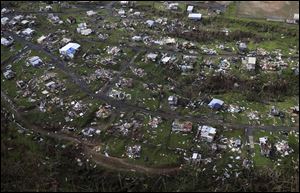
EDITORIAL
The swamp after the storm
12/11/2017
Homes and other buildings destroyed by Hurricane Maria lie in ruins in Toa Alta, Puerto Rico, on Sept. 28. Much of the country is still without power.
Facing unanswerable criticism from members of Congress and the Federal Emergency Relief Agency back in November, the governor of Puerto Rico canceled the $300 million contract awarded to a small Montana company to rebuild part of the island’s battered power grid.
Just how small is the company? A profile on a site that tracks federal contracts lists the firm, named Whitefish Energy Holdings, as having just two employees and $1 million in annual revenue.
Click here to view more Blade editorials
One doesn’t have to be an electrical engineer to question their ability to rebuild the grid of an island of 3.4 million people, many of whom are still without power.
Obviously, a tiny, inexperienced company like Whitefish was a mystifying choice for this job. But it makes more sense in light of the fact that Whitefish is based in the hometown of the Secretary of the Interior, Ryan Zinke, and the company’s chief executive, Andy Techmanski, is his neighbor.
It also makes sense in light of recent history. Increasingly, corruption seems endemic to U.S. government-funded humanitarian rebuilding programs.
When a 7.0 earthquake struck Haiti in January, 2010, an estimated 316,000 people were killed, and another two million were forced from their homes. More than $10 billion dollars in foreign aid later, 2.5 million Haitians are still in need of humanitarian aid, according to the most recent estimates by the U.N.
The Haitian contracts consistently prioritized the interests of the companies performing the services — and those of their benefactors in Washington — well above the needs of the displaced.
Take Clayton Homes, the recipient of a contract to build “hurricane-proof ... emergency shelters that can also serve as schools … to ensure the safety of vulnerable populations in high-risk areas during the hurricane season.”
When a team of reporters visited the shelters six to eight months after installation, they found “20 imported prefab trailers beset by a host of problems, from mold to sweltering heat to shoddy construction.” The trailers were also leaking high levels of formaldehyde, a carcinogen.
Or InnoVida, recipient of $10 million in loans from the U.S. government to build 500 homes in Haiti. Before a single house had gone up, the company defaulted on the loan.
So why did Clayton Homes and InnoVida get contracts? Both had donated handsomely to the Clinton Foundation, and Hillary Clinton, at the time, was well-placed to reward those contributions. There were numerous other such instances.
Another natural disaster in the Caribbean, seven years after the scandal that was the U.S. government’s attempt to rebuild Haiti, a similar pattern re-emerges.
Humanitarian relief programs funded by American taxpayers need much closer oversight than they have gotten. The abuses are manifold, extravagant, and by now, predictable. Whitefish was relatively easy to catch for the scheme’s sheer boldness. But how many other sweetheart deals are hiding in how many more cleaner-seeming contracts?